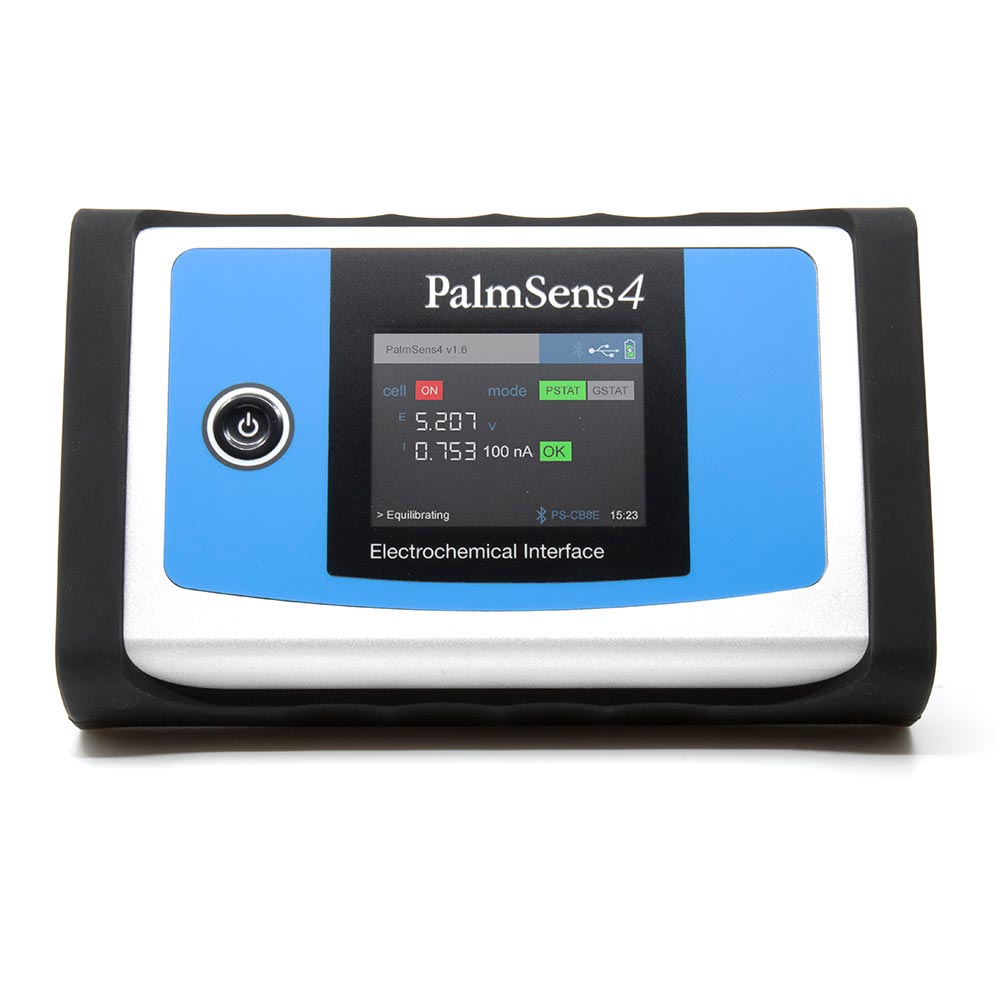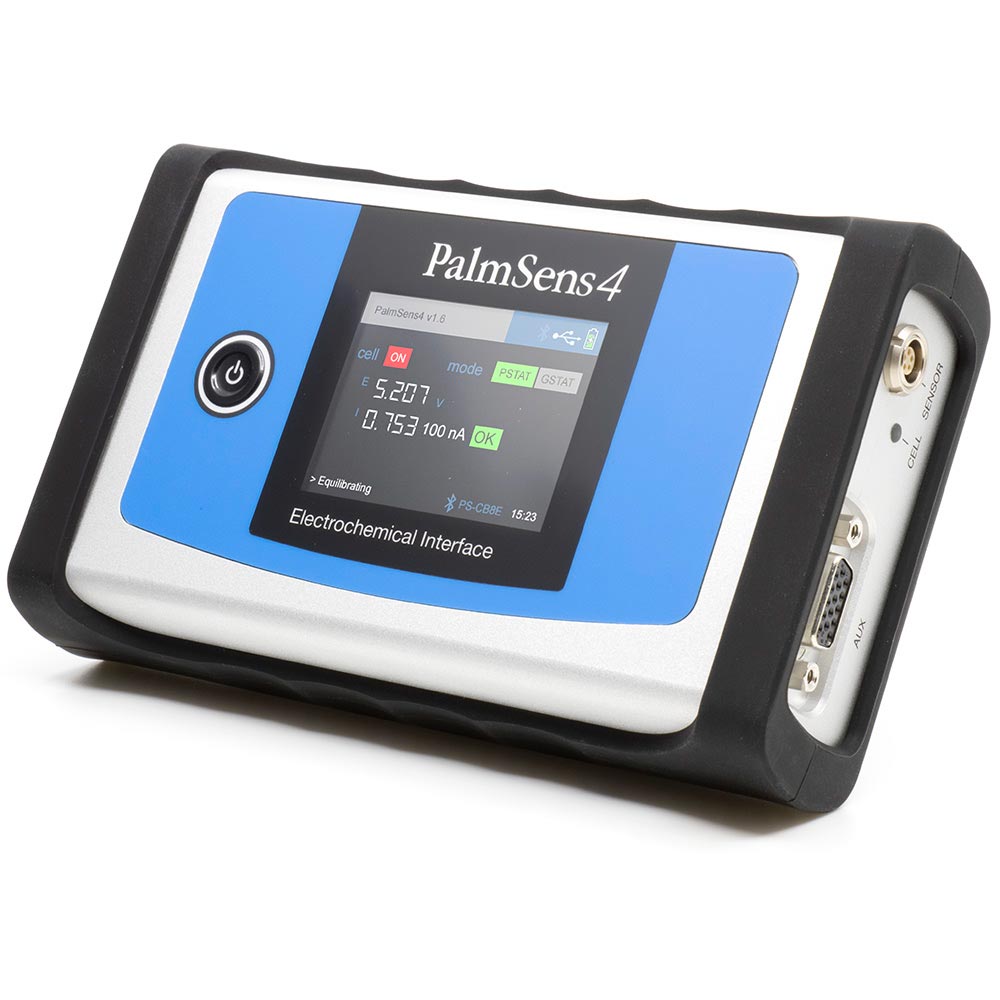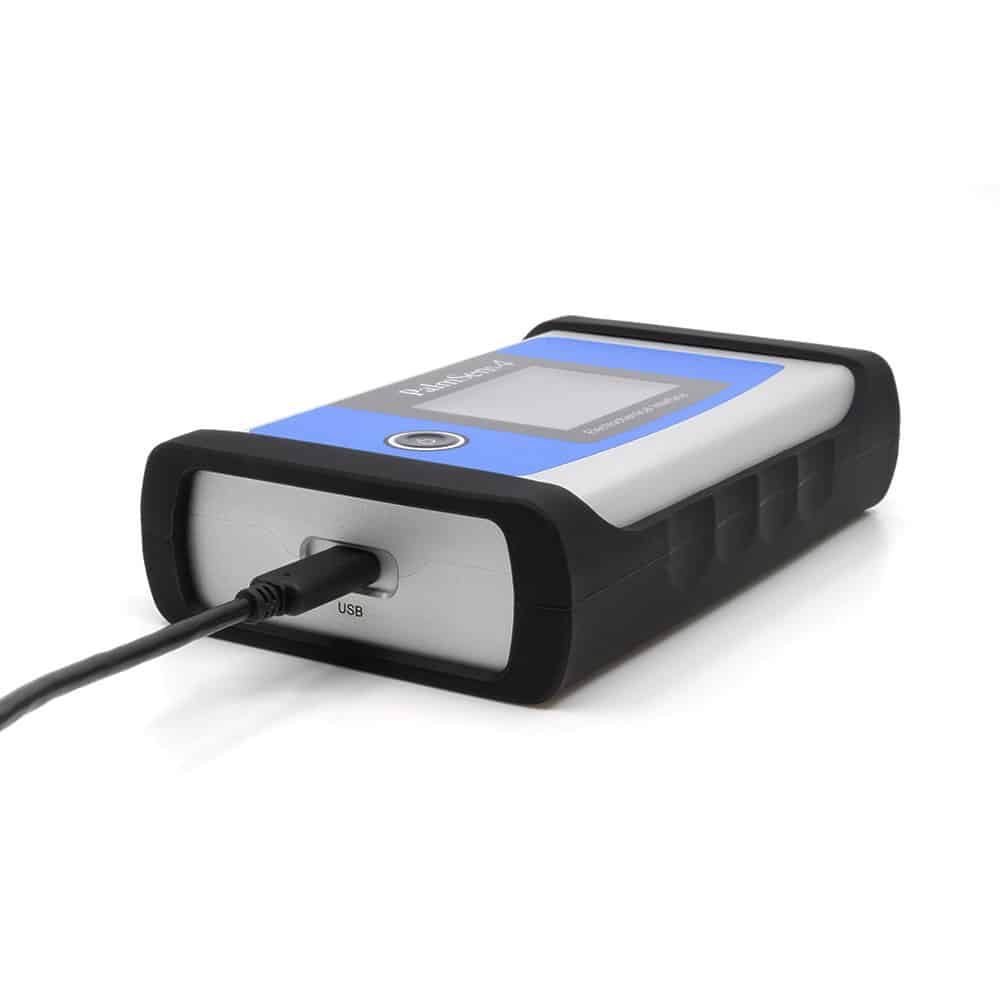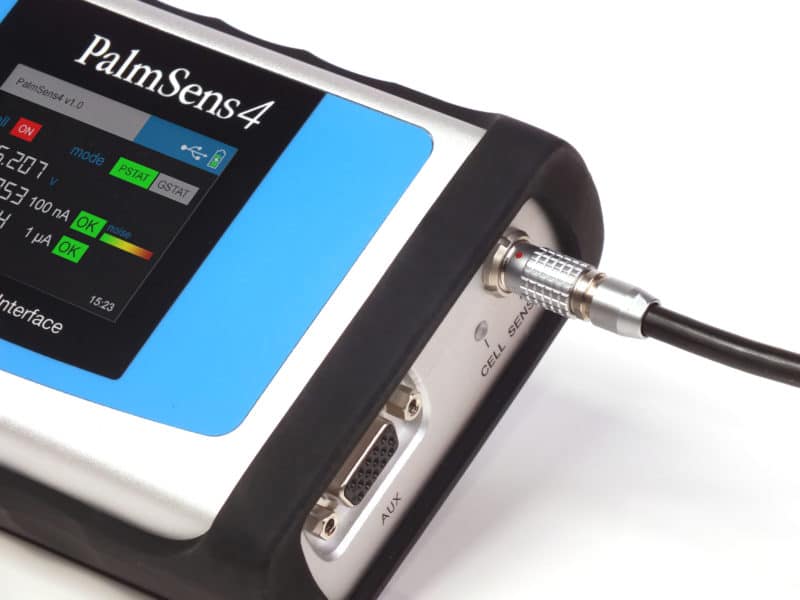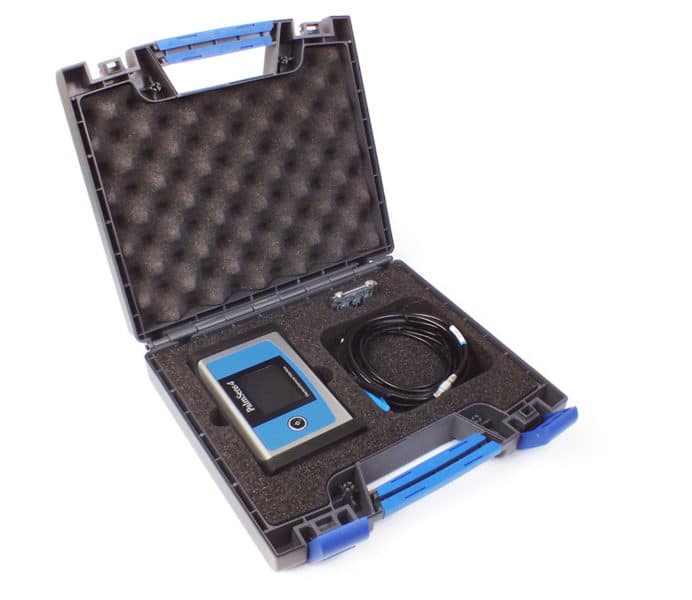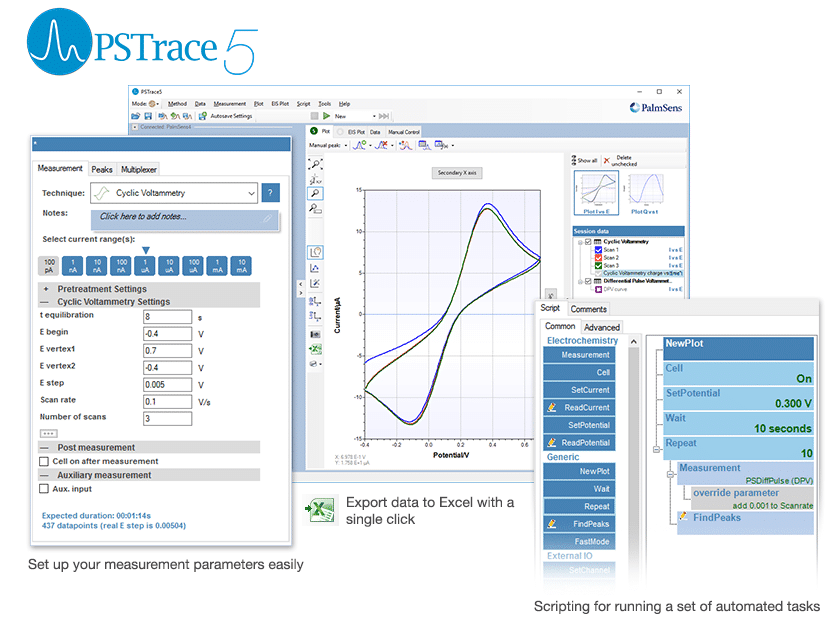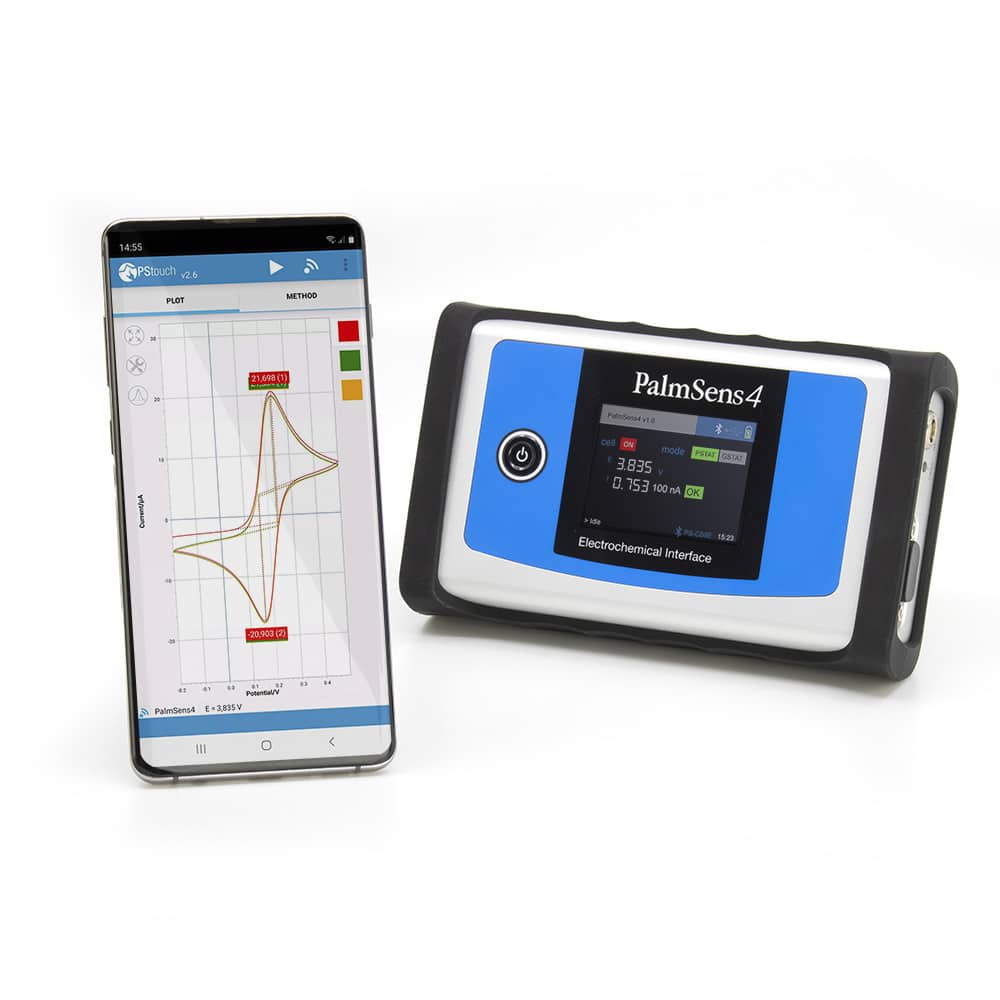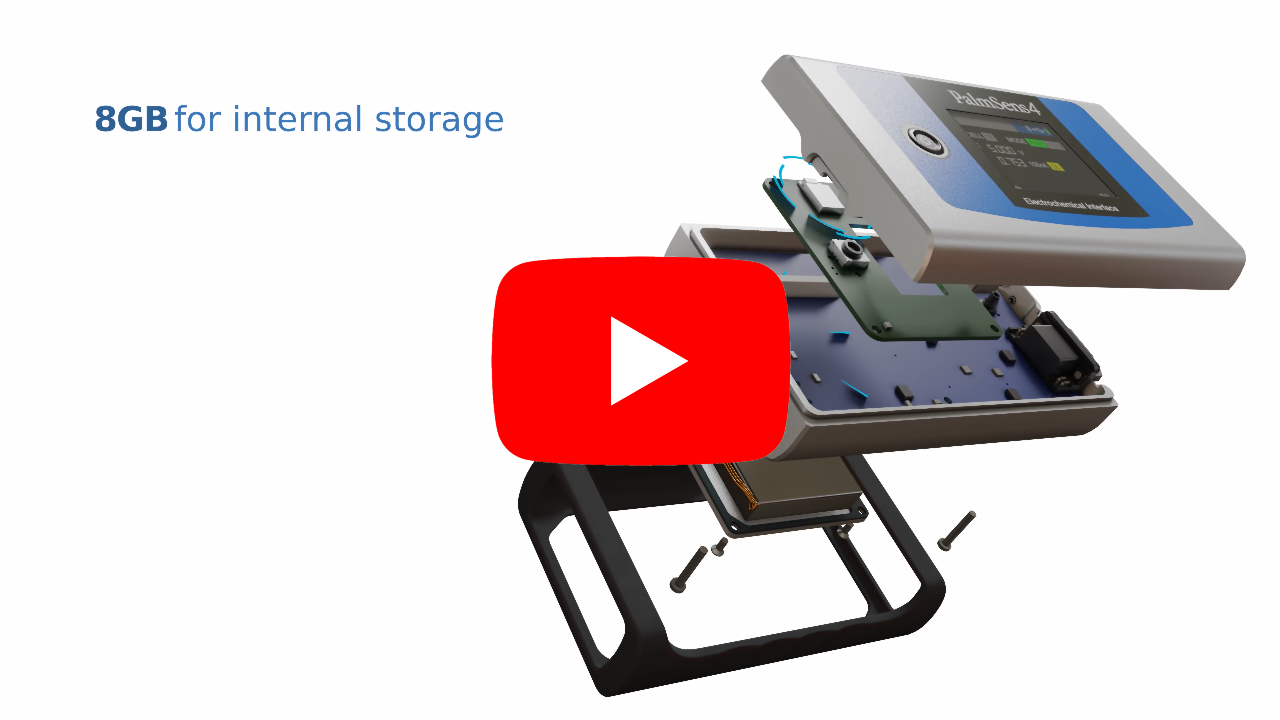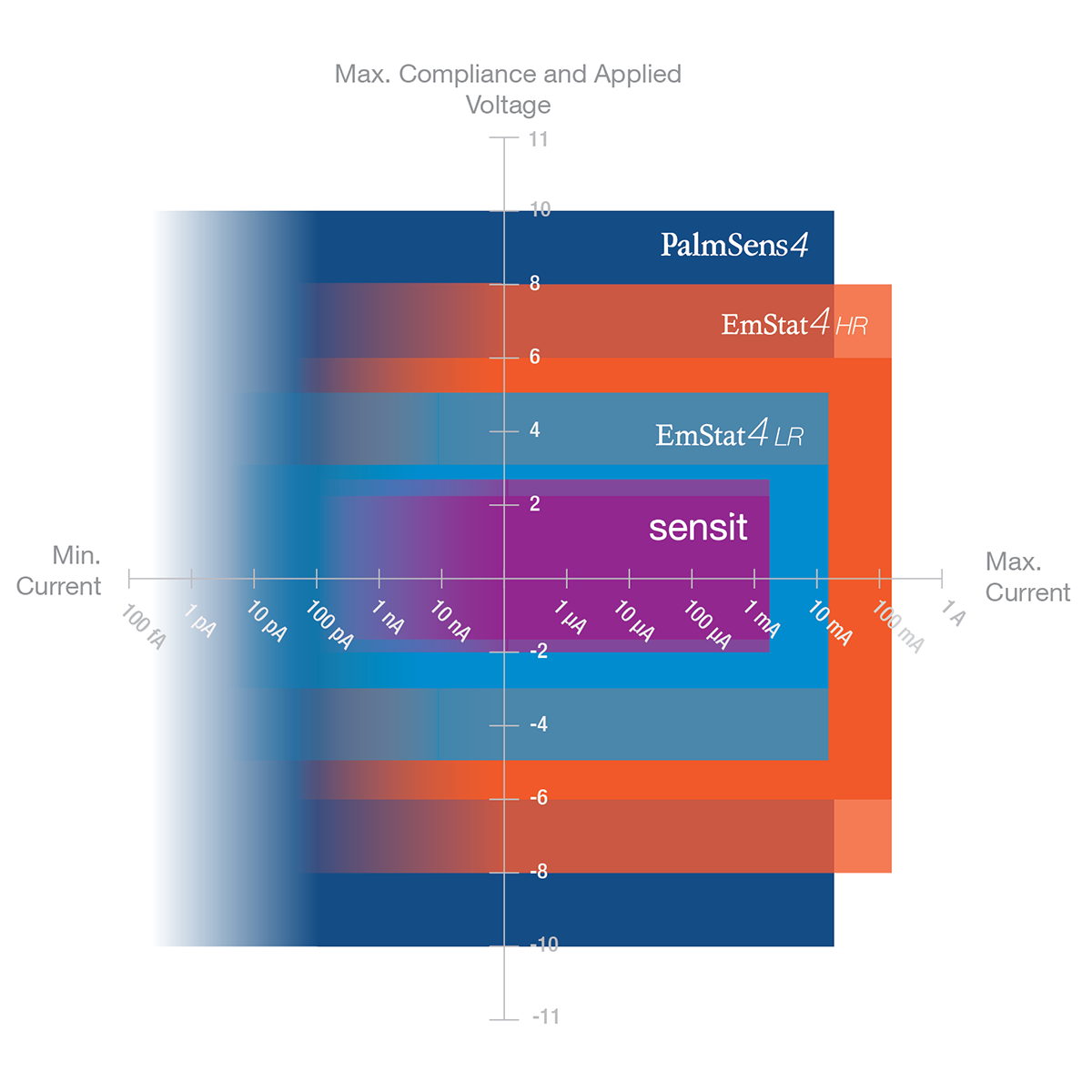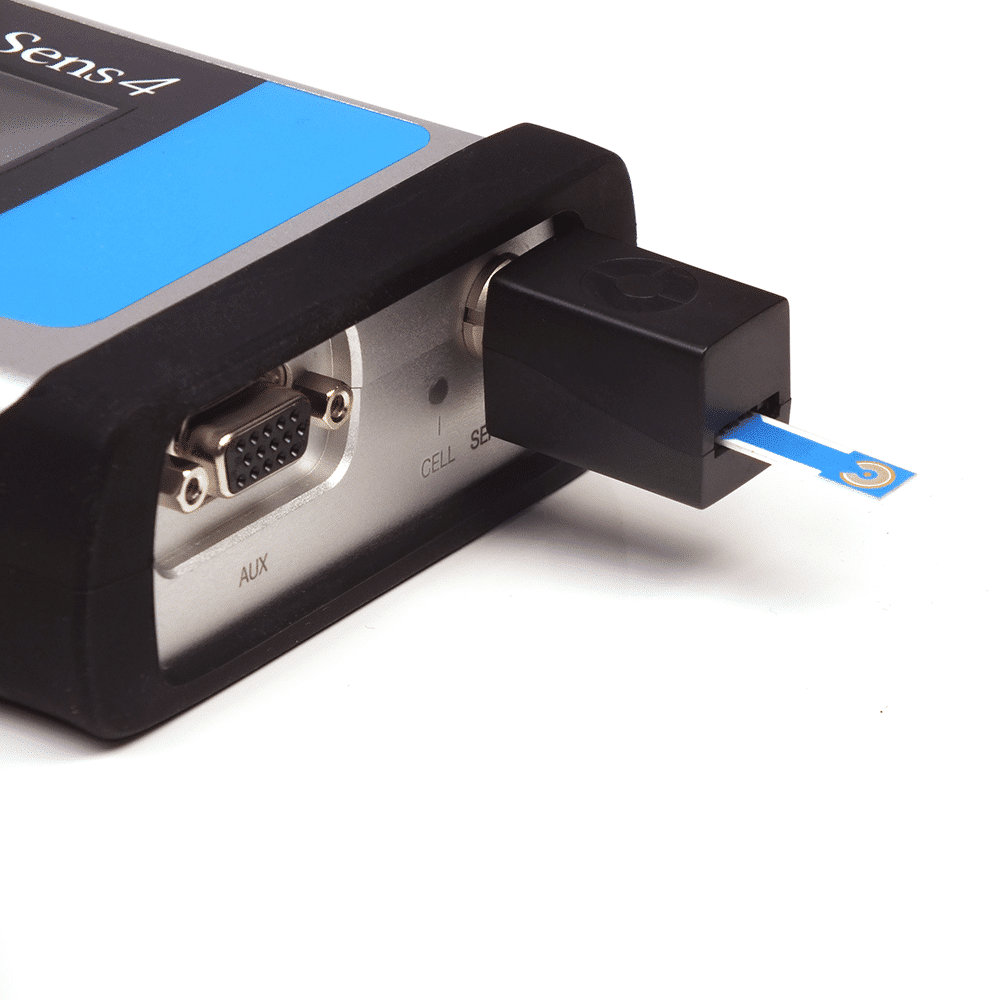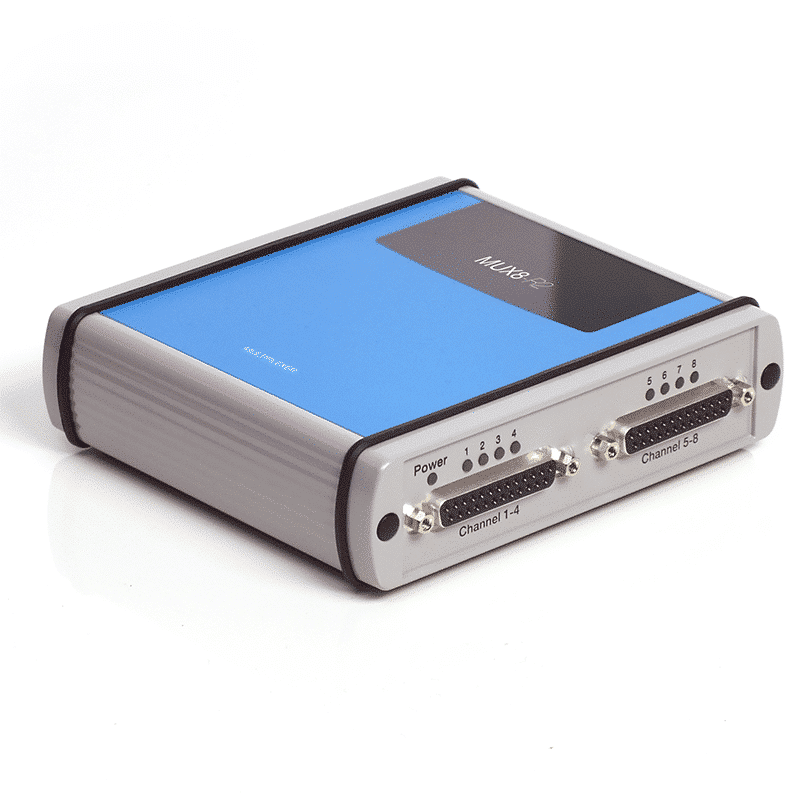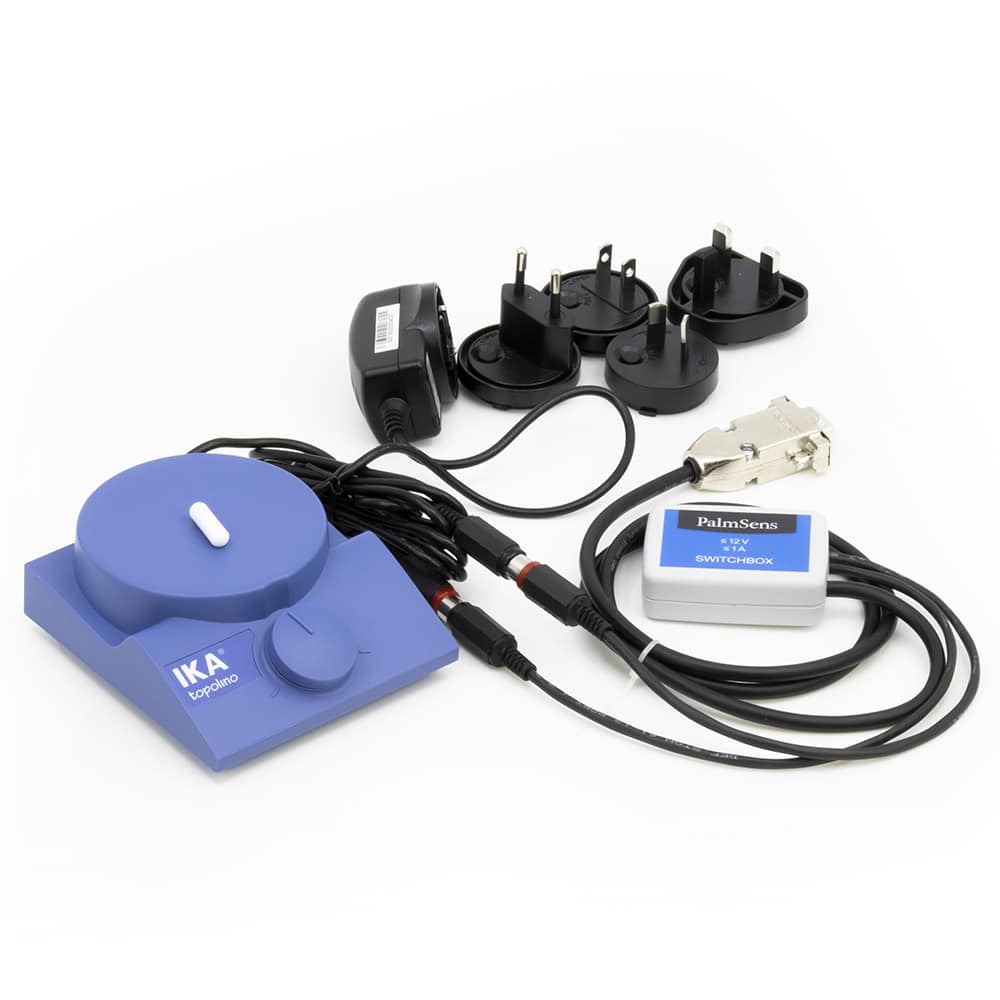PalmSens4
Compact, versatile and powerful
- (Bi)Potentiostat / Galvanostat / Impedance Analyzer
- FRA / EIS: 10 μHz up to 1 MHz
- 9 current ranges: 100 pA to 10 mA
- 18-bit resolution
- Bluetooth or USB connection
Description
Our flagship instrument, the PalmSens4, is a USB and battery powered Potentiostat, Galvanostat, and optional a Frequency Response Analyser (FRA) for Electrochemical Impedance Spectroscopy (EIS). The PalmSens4 has a large potential range (-5V to 5V or -10V to 10V) and current range (100 pA to 10 mA) with a high resolution and low noise. The economical PalmSens4 is a complete laboratory instrument but its compact and rugged design makes it also ideal for field work. Connecting via Bluetooth guarantees a perfectly floating measurement.
Configurable
PalmSens4 comes in different configurations:
- ±5 V or ±10 V potential range
- EIS/FRA with maximum frequency of 100 kHz or 1 MHz
- optional BiPotentiostat module for second WE
- optional iR-Compensation
Standard included
- Rugged carrying case
- High quality, double shielded cell cable with
2 mm banana connectors for Working, Counter, Reference electrode and Ground - Crocodile clips
- Dummy cell
- USB cable
- Manual and Quick Start document
- PSTrace software for Windows
Always a backup
Every PalmSens4 is equipped with an internal storage of 8 GB. This means all your measurements* can automatically be saved on-board as backup.Measurements can be browsed and transferred to the PC easily using the PSTrace software for Windows.
Accessories
Accessories for PalmSens4
You may also like…
Specifications
| General | ||
|---|---|---|
| configuration | PS4.F#.05 | PS4.F#.10 |
dc-potential range
The maximum potential difference, that can be applied between WE and RE.
|
±5 V | ±10 V |
compliance voltage
The compliance voltage is the maximum voltage that can be applied between the working and counter electrode. Another name could be the maximum cell potential. Continue reading
|
±10 V | |
| maximum current | ±30 mA (typical) | |
| Potentiostat (controlled potential mode) | |
|---|---|
applied dc-potential resolution
The lowest observable difference between two values that a measurement device can differentiate between.
|
76.3 µV ( 18-bit )
An 18 bit input can measure in 2^18 or roughly 262 thousand different steps. If you measure for example an analog voltage that can go from 0 to 5V, the accuracy is 5 divided by 262k, resulting in resolution of 20 uV. Continue reading
|
applied potential accuracy
The applied potential accuracy describes how close to the real values your applied potential is.
|
≤0.1% ±1 mV offset |
current ranges
A potentiostat measures current. For optimal precision, the range between which currents are measured is split into multiple current ranges. A current range defines the maximum current a potentiostat can measure in a certain range. This means it will also determine the resolution, because the number of bits or rather states is fixed, while the current range is variable.
|
100 pA to 10 mA (9 ranges) |
current accuracy
The current accuracy describes how close to the real values your measured current is.
|
< 0.2% of current ±10 pA ±0.1% of range |
measured current resolution
The lowest observable difference between two values that a measurement device can differentiate between.
|
0.005 % of current range ( 18-bit , 5 fA on 100 pA range)
An 18 bit input can measure in 2^18 or roughly 262 thousand different steps. If you measure for example an analog voltage that can go from 0 to 5V, the accuracy is 5 divided by 262k, resulting in resolution of 20 uV. Continue reading
0.0025% of 10 mA range |
| Galvanostat (controlled current mode) | |
|---|---|
current ranges
A potentiostat measures current. For optimal precision, the range between which currents are measured is split into multiple current ranges. A current range defines the maximum current a potentiostat can measure in a certain range. This means it will also determine the resolution, because the number of bits or rather states is fixed, while the current range is variable.
|
1 nA to 10 mA (8 ranges) |
| applied dc-current | ±6 times applied current range |
| applied dc-current resolution | 0.0076% of applied current range (<10 mA) 0.0038% of 10 mA range |
| applied dc- current accuracy
The current accuracy describes how close to the real values your measured current is.
|
< 0.2% of current ±10 pA ±0.1% of range |
| potential ranges | 10 mV, 100 mV, 1 V |
| measured dc-potential resolution | 78.13 μV at ±10 V 7.813 μV at ±1 V 0.7813 μV at ±0.1 V |
| measured dc-potential accuracy | ≤ 0.05% or ±1 mV (for |E| < ±9 V) ≤ 0.2% (for |E| ≥ ±9 V) |
| FRA / EIS (impedance measurements) | ||
|---|---|---|
| Configuration | PS4.F0.## | PS4.F1.## |
| frequency range | 10 μHz to 100 kHz | 10 μHz to 1 MHz |
| ac-amplitude range | 1 mV to 0.25 V rms, or 0.7 V p-p | |
| GEIS (galvanostatic impedance measurements) | |
|---|---|
| frequency range | 10 μHz to 100 kHz |
| ac-amplitude range | 0.001 x CR to 0.4 x CR (<10 mA) 0.001 x CR to 0.2 x CR (10 mA) (CR = current range) |
| Electrometer | |
|---|---|
electrometer amplifier input
The amplifier input resistance of the amplifier in the electrometer determines the load that the amplifier places on the source of the signal being fed into it. Ideally the resistance is infinite, and the load to be zero to not to influence your measurement.
|
> 1 TΩ // 10 pF |
| bandwidth | 1 MHz |
| Other | |
|---|---|
| housing | aluminium with rubber sleeve: 15.7 x 9.7 x 3.5 cm |
| weight | +/- 500 g |
| temperature range | 0 ºC to + 50 ºC |
| power supply | USB or internal LiPo battery |
| communication | USB and Bluetooth (Dual Mode) |
| battery time | > 16 hours idle time > 4 hours with cell on at max. current extendable by means of power bank |
| internal storage space | 8 GB or +/- 800000 measurements incl. method info (assuming 200 data points per measurement) |
| Auxiliary port (D-Sub 15) | |
|---|---|
| analog input | ±10 V, 18-bit
An 18 bit input can measure in 2^18 or roughly 262 thousand different steps. If you measure for example an analog voltage that can go from 0 to 5V, the accuracy is 5 divided by 262k, resulting in resolution of 20 uV. Continue reading
|
| analog output | 0-10 V, 12 bit (1 kOhm output impedance) |
| 4 digital outputs | 0-5 V |
| 1 digital input | 0-5 V |
| i-out and E-out | raw output of current and potential E-out ±10 V (1 kOhm output impedance) i-out ±6 V (1 kOhm output impedance) |
| power | 5 V output (max. 150 mA) |
| EIS Accuracy Contour Plot |
|---|
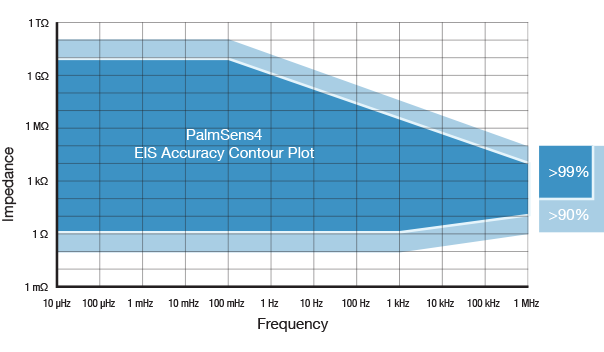 |
Software
PSTrace
PSTrace is designed to be productive immediately after installation, without going through a long learning period. It has three modes; the Scientific mode which allows you to run all the techniques our instruments have to offer, and two dedicated modes for Corrosion analysis and the Analytical Mode. PSTrace is suitable for all levels of user experience.
Features include:
- Direct validation of method parameters
- Automated peak search
- Equivalent Circuit Fitting
- Scripting for running an automated sequence of measurements
- Open data in Origin and Excel with one click of a button
- Load data from the instrument’s internal storage
- and many more…
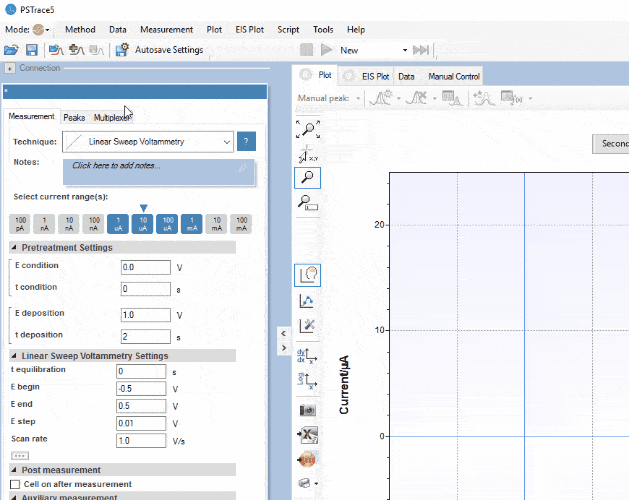
PStouch
PStouch is an app for Android devices compatible with all PalmSens, EmStat and Sensit potentiostats. The app connects to your potentiostat via USB (depending on the Android device) or via Bluetooth.
PStouch features include:
- Setting up and running measurements
- All files compatible with PSTrace
- Analysing and manipulating peaks
- Sharing data directly via e-mail, Dropbox, or any other file sharing service
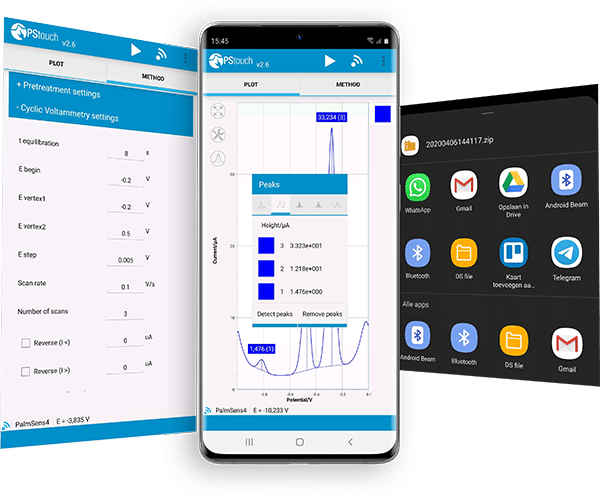
Software Development Kits
PalmSens provides several Software Development Kits (SDKs) to help developers create custom software to control their potentiostat. Each SDK comes with documentation and examples that shows how to use the libraries.
SDKs are available for:
- .NET (WinForms, WPF and Xamarin for Android)
- Python
- LabVIEW
- Matlab
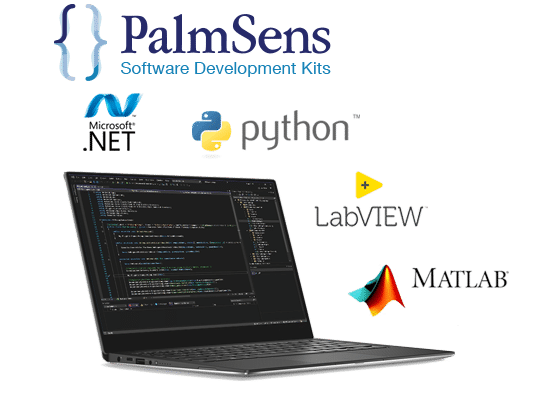
Downloads
Documentation (4)
| Name | Last updated | |
|---|---|---|
| PalmSens4 Brochure PalmSens4 Brochure | 10-03-25 | |
| PalmSens4 Operator’s Manual Learn how to connect the instrument, understand the specifications, use the features and troubleshoot if needed. | 13-03-24 | |
| PalmSens4 IR Compensation Module – Brochure This document describes the IR Compensation Module for PalmSens4. The module is available as an in-factory add-on module and provides positive feedback to compensate for the IR drop between the Reference electrode and the outside of the double layer of the electrochemical cell. | 09-09-22 | |
| PalmSens4 BiPot – Brochure For using an additional working electrode with your PalmSens4 to make it an BiPotentiostat. | 09-09-22 |
Software (1)
| Name | Last updated | |
|---|---|---|
| PSTrace PC software for all single channel instruments PSTrace software is shipped as standard with all single channel and multiplexed instruments. The software provides support for all techniques and device functionalities. | 08-07-24 |
Application Note (4)
| Name | Last updated | |
|---|---|---|
| Potentiostatic and Galvanostatic EIS What is GEIS? When to use GEIS or PEIS? | 14-12-20 | |
| PalmSens4 Connecting via Bluetooth This document shows how to connect the PalmSens4 via Bluetooth to PSTrace (for Windows) or PStouch (for Android) | 08-04-20 | |
| PalmSens4 example calibration report PalmSens4 example calibration report | 08-04-20 | |
| Galvanic Isolation In this application note the galvanic isolation options are discussed for the different PalmSens instruments as well as the effect of galvanic isolation on your measurement. | 08-04-20 |






























